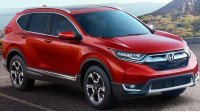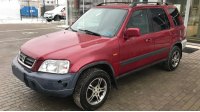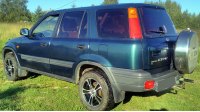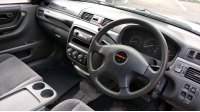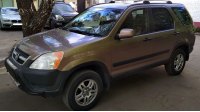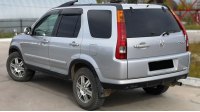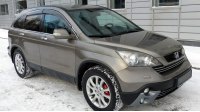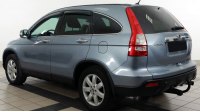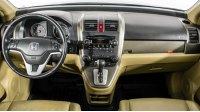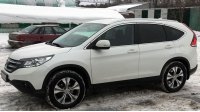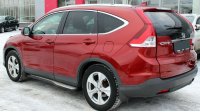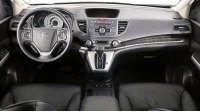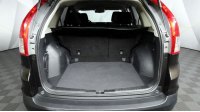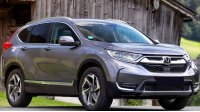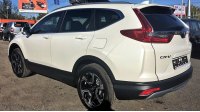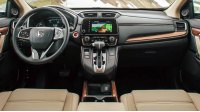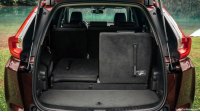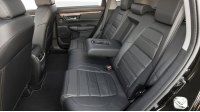The main classmates and competitors are Audi Q3, BMW X3, Chevrolet Captiva, Cherry Tiggo, Citroen C-Crosser, Ford Kuga, Hyundai Tucson, Infiniti QX30, Jeep Cherokee, Kia Sportage, Land Rover Freelander, Mazda CX-5, Mitsubishi Outlander, Mitsubishi ASX, Nissan Qashqai, Nissan X-Trail, Opel Antara, Peugeot 4007, Renault Duster, Skoda Kodiaq, Subaru Forester, Suzuki Vitara, Suzuki SX4, Toyota RAV4, Volkswagen Tiguan.
First generation (RD1-RD3, 1995−2001)
The first generation appeared in 1995 in Japan and the car became the first crossover developed by the company «Honda». For the North American market «CR-V» was introduced at the 1996 Chicago Auto Show with sales beginning in February 1997. The body of the car is load-bearing, the suspension is independent with two wishbones. Inside, the rear seats could fold down, and a fold-out picnic table was stowed away in the rear floor area. At first there was only one trim level - «LX». On the outside, a plastic cladding covers the front and rear bumpers as well as the wing wells. Trim level came later «EX», which included anti-lock brakes and 15-inch alloy wheels. The total length of the car was 4510 mm, width 1780 mm, height 1678-1725 mm. After 1999, the height was 1745-1770 mm.
Since its release, only one engine has been installed - a 2.0-liter four-cylinder gasoline (1973 cm3, B20B) 126 hp The engine used a one-piece cylinder liner design common to any other engine in the series «B». Transmission 5-speed manual «SBXM AWD» or «SKH FWD», as well as a 4-speed automatic «MDMA» or «MDLA».
In 1999, the model was updated. The engine was replaced with a two-liter «B20Z2» with a capacity of 147 hp, which had a positive effect on the dynamics of a one and a half ton car. Fuel consumption was 10 liters per 100 km when driving in the city, 8.4 liters per 100 km on the highway. The appearance of the bumpers has also changed and new body colors have appeared.
Trim level introduced in North America in 2000 «SE» (Special Edition), which was equipped with colored bumpers and side plates, a colored spare wheel cover, leather upholstery, a CD / cassette audio system, tinted rear window, a navigation system «Navtech» and chrome grille, as well as new paint colors.
The 1997 model was tested by the American «Insurance Institute for Highway Safety» (IIHS) with front airbags. Corps rated «acceptable», and the overall rating «extremely» due to the broken leg of the mannequin, the head restraints were rated «acceptable».
American agency «National Highway Traffic Safety Administration» (NHTSA) also crash-tested a 2001 car, with the following results:
- frontal impact (driver) — 4 out of 5 stars
- frontal impact (passenger) — 5 out of 5 stars
- Side kick (driver) — 5 out of 5 stars
- Side kick (passenger) — 5 out of 5 stars
- Car flip - 3 out of 5 stars
Second generation (RD4-RD9, 2002−2006)
The second generation appeared in 2002 and shares a platform with «Civic» seventh generation. The new chassis had increased torsional and flexural rigidity. The length of the car was 4535 mm (4600 mm after 2005), width 1785 mm, height 1680-1800 mm. Trunk volume was increased due to the increase in the length of the car and the use of a compact rear suspension. popular american magazine «Car and Driver» gave the car an award «Best compact crossover» in 2002 and 2003.
Engines were installed four-cylinder petrol 2.0 liters (1998 cm3, K20A4, 150 hp) and 2.4 liters (2354 cm3, K24A1, 160 hp). For the first time, a 2.2-liter four-cylinder turbocharged diesel engine was installed (2204 cm3, N22A1, 140 hp). The car retained the fuel consumption of the previous generation of the model thanks to the system «i-VTEC». Transmission 5-speed manual or 4 and 5-speed automatic. All-wheel drive, there is also a more budgetary front-wheel drive.
In 2005, the model was updated. They began to install new 16-inch wheels, changed the rear lights, front lights, fog lights, grille, front bumper design and rear bumper reflectors. A temperature sensor was installed in the cabin, the rear seat head restraints were changed. For cars for North American markets, they began to install ABS, brake force distribution system, dynamic stabilization system, traction control, side airbags and rollover sensors. The most expensive configurations had a leather interior, a leather steering wheel and heated side mirrors and front seats.
Third generation (RE1-RE5, RE7, 2007−2011)
In September 2006, the third generation went on sale «Honda SRV» as a 2007 model. The very first thing that catches your eye is the lack of a spare tire on the back door (put it in the trunk), and the back door began to open up, and not sideways. The length of the car was 4518 mm, width 1820 mm and height 1704 mm. The length has decreased due to the fact that the spare tire no longer increases it, and the center of gravity has also decreased. Trim and trim levels offered «LX», «EX» And «EX-L». This car entered the top ten best selling cars of 2007. He overtook «Ford Explorer», who held the title for fifteen years (1991–2006), as the best-selling SUV in the US.
Gasoline engines were represented by the following models - 2.0 liters (1997 cm3, R20A1/R20A2, 148 hp) and 2.4 liters (2354 cm3, K24Z1, 166 hp). The diesel engine was carried over from the second generation. The gearbox was a 6-speed manual or 5-speed automatic.
Equipment «EX-L» equipped with a navigation system with voice control of the company «Alpine», satellite radio, CD player or 6 CD changer that could play MP3 files, rear backup video camera.
In 2010, they carried out an update that affected the design, transmission and equipment. The look has changed with new front and rear bumpers, a new chrome grille, new taillights and new 17-inch alloy wheels. The interior received minor changes. The audio controls have been changed. The backlighting of the information display in the indicators has been changed to blue. The power of the 2.4-liter engine has been increased to 180 hp. Gasoline consumption was 11 liters per 100 km in the city and 8.7 liters per 100 km on the highway.
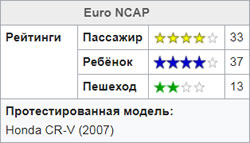
- Frontal Impact - 5 out of 5 stars
- Side impact - 5 out of 5 stars
- Car flip - 4 out of 5 stars
Fourth generation (RM1, RM3, RM4, 2012−2016)
The fourth generation was presented to the public in November 2011 at the Los Angeles International Auto Show. Sales began in December 2011 as a 2012 model. The length of the car was 4529 mm, width 1819 mm, height 1654 mm. The engine is located transversely in front, which works in conjunction with the intelligent all-wheel drive system «Real-Time All-Wheel Drive». There was also a more budget option with front-wheel drive.
For different markets, four-cylinder gasoline engines of the following volumes were used - 2.0 liters (1997 cm3, R20A, 148 hp), 2.4 liters (2354 cm3, K24Z1, 166 hp) and 2.4 liters (2356 cm3, K24W, 185 hp). Diesel engines were two models of 1.6 liters (1598 cm3, N16A1, i-DTEC, 118 hp) and 2.2 liters (2199 cm3, N22B, i-DTEC, 148 hp). Gearbox 6-speed manual, 5 or 9-speed automatic, as well as stepless variator.
In October 2014, an updated «CR-V» 2015 model year. New direct injection engine «Earth Dreams» and continuously variable transmission (CVT). This made it possible to increase the efficiency of the car. Suspension dampers, springs, anti-roll bars and lower control arms have been updated to improve ride quality.
Top-tier trims include forward collision warning with forward collision braking, lane departure warning, lane keep assist and adaptive cruise control, as well as a power liftgate, power memory seats, power side mirrors and memory, projector headlights and direction indicators built into the side mirrors.
American agency «National Highway Traffic Safety Administration» (NHTSA) conducted crash tests of the car in 2012:
- frontal impact (driver) — 4 out of 5 stars
- frontal impact (passenger) — 4 out of 5 stars
- Side kick (driver) — 5 out of 5 stars
- Side kick (front passenger) — 5 out of 5 stars
- Side kick (rear passenger) — 5 out of 5 stars
- Rollover resistance - 4 out of 5 stars
NHTSA retested in 2016:
- frontal impact (driver) — 5 out of 5 stars
- frontal impact (passenger) — 5 out of 5 stars
- Side kick (driver) — 5 out of 5 stars
- Side kick (passenger) — 5 out of 5 stars
- Rollover resistance - 4 out of 5 stars
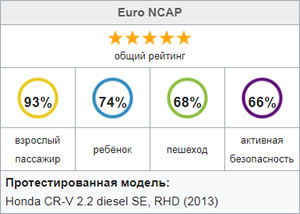
- Frontal test with partial overlap - Good
- Small overlap frontal test (until 2014) - Extremely
- Small overlap frontal test (since 2015) - Fine
- Side kick - good
- Roof strength - Good
The European agency Euro NCAP of the 2013 model also conducted its tests, see the results in the table.
Fifth generation (RW1–RW6, 2017–present)
Fifth generation «CR-V» was introduced in October 2016 in Detroit and sales began in December 2016 as a 2017 model. Shares the same platform as «Civic» tenth generation. Body length 4587 mm, width 1854 mm, height 1679-1689 mm and curb weight 1500-1593 kg. Production is carried out in Japan, India, Indonesia, Canada, China, Malaysia, Mexico, USA, Taiwan and Thailand.
Three models of 1.5-liter four-cylinder petrol engines are installed (1498 cm3, L15B7 VTC turbo, 190 hp), 2.0 liters (1997 cm3, R20A2, 148 hp) and 2.4 liters (2356 cm3, K24W, 185 hp). There is also one 1.6-liter turbodiesel (1598 cm3, N16, i-DTEC, I4, 160 hp). Gasoline engines are paired with a continuously variable transmission (CVT variator), and the diesel engine is paired with a 9-speed automatic «ZF».
Plastic bag «Honda Sensing», which includes features such as adaptive cruise control, forward collision braking and lane keeping assist, are standard on trim levels «EX» and higher. New safety features are also introduced: blind spot information with rear cross traffic monitor, auto high beam headlights, LED daytime running lights, electronic parking brake with new auto hold function. Additional new features include a power tailgate, active grille shutters to reduce aerodynamic drag, Android Auto and Apple CarPlay support on an updated 7-inch touchscreen display with volume control, and LED headlights.
American agency «National Highway Traffic Safety Administration» (NHTSA) tested the safety of the 2017 model, the results were as follows:
- Overall rating - 5 out of 5 stars
- frontal impact (driver) — 5 out of 5 stars
- frontal impact (passenger) — 5 out of 5 stars
- Side kick (driver) — 5 out of 5 stars
- Side kick (passenger) — 5 out of 5 stars
- Rollover resistance - 4 out of 5 stars

